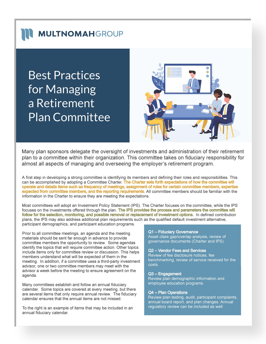Many plan sponsors delegate the oversight of investments and administration of their retirement plan to a committee within their organization. This committee takes on fiduciary responsibility for almost all aspects of managing and overseeing the employer’s retirement program.
A first step in developing a strong committee is identifying its members and defining their roles and responsibilities. This can be accomplished by adopting a Committee Charter. The Charter sets forth expectations of how the committee will operate and details items such as frequency of meetings, assignment of roles for certain committee members, expertise expected from committee members, and the reporting requirements. All committee members should be familiar with the information in the Charter to ensure they are meeting the expectations.
Most committees will adopt an Investment Policy Statement (IPS). The Charter focuses on the committee, while the IPS focuses on the investments offered through the plan. The IPS provides the process and parameters the committee will follow for the selection, monitoring, and possible removal or replacement of investment options. In defined contribution plans, the IPS may also address additional plan requirements such as the qualified default investment alternative, participant demographics, and participant education programs.
Prior to all committee meetings, an agenda and the meeting materials should be sent far enough in advance to provide committee members the opportunity to review. Some agendas identify the topics that will require committee action or a decision from items only for review or discussion. This helps members understand what will be expected of them in the meeting. In addition, if a committee uses a third-party investment advisor, one or two committee members may meet with the advisor a week before the meeting to ensure agreement on the agenda.
Many committees establish and follow an annual fiduciary calendar. Some topics are covered at every meeting, but there are several items that only require annual review. The fiduciary calendar ensures that the annual items are not missed. Below is an example of items that may be included in an annual fiduciary calendar.
- Q1 – Fiduciary Governance – Asset class gap/overlap analysis, review of governance documents (Charter and IPS)
- Q2 – Vendor Fees and Services – Review of fee disclosure notices, fee benchmarking, review of service received for the costs.
- Q3 – Engagement – Review plan demographic information and employee education programs
- Q4 – Plan Operations – Review plan testing, audit, participant complaints, annual board report, and plan changes. Annual regulatory review can be included as well.
In addition to these quarterly topics, there are important items that are part of every meeting. Most meetings begin with the review and approval of the prior meeting minutes. This step can be overlooked, but is an important way to monitor that the decisions being made are completed. Every meeting also includes a general update on the overall markets and a review of the specific investment options in the plan. The investment review should include any changes to recommendations such as addition or removal from a watch list or a recommendation for removal or replacement of a fund. Each quarter should also include discussion around regulatory changes and proposed plan enhancements. These topics ensure the committee is reviewing items outside the day-to-day plan administration that may impact or benefit the plan.
A final item that should be included in some, if not all, meetings is fiduciary education. It is critical that committees continually educate all members on their role as fiduciary and their responsibility to the plan participants. Ongoing fiduciary education also keeps committees apprised of current topics and trends that could impact their plan and participants.
Well-run committees have a defined process that ensures they are meeting their fiduciary requirements. They get materials to members with enough time to review before the meeting. Agendas define the flow of the meeting and help with decision-making. For decision items, an owner is assigned to execute the decision, and they report back on their success at future meetings. Minutes capture the topics discussed and describe the reasoning for any decisions that were made.
 Interested in a downloadable best practices for managing a retirement plan committee resource?
Interested in a downloadable best practices for managing a retirement plan committee resource?
You can access the resource here.
Multnomah Group is a registered investment adviser, registered with the Securities and Exchange Commission. Any information contained herein or on Multnomah Group’s website is provided for educational purposes only and does not intend to make an offer or solicitation for the sale or purchase of any specific securities, investments, or investment strategies. Investments involve risk and, unless otherwise stated, are not guaranteed. Multnomah Group does not provide legal or tax advice. Any views expressed herein are those of the author(s) and not necessarily those of Multnomah Group or Multnomah Group’s clients.

